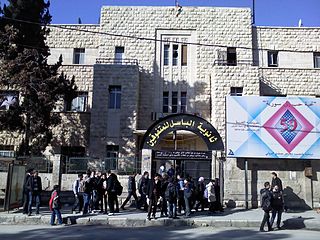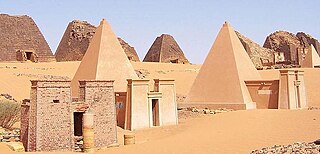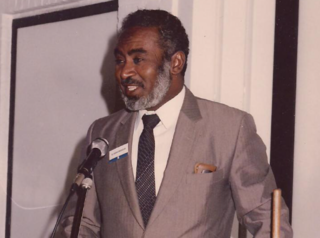
Khartoum or Khartum is the capital of Sudan. With a population of 6,344,348, Khartoum's metropolitan area is the largest in Sudan.

Secondary education or post-primary education covers two phases on the International Standard Classification of Education scale. Level 2 or lower secondary education is considered the second and final phase of basic education, and level 3 upper secondary education or senior secondary education is the stage before tertiary education. Every country aims to provide basic education, but the systems and terminology remain unique to them. Secondary education typically takes place after six years of primary education and is followed by higher education, vocational education or employment. In most countries secondary education is compulsory, at least until the age of 16. Children typically enter the lower secondary phase around age 12. Compulsory education sometimes extends to age 20.

Omdurmán is a major city in Sudan. It is the second most populous city in the country, and thus also in the State of Khartoum. Omdurman lies on the west bank of the River Nile, opposite and northwest of the capital city of Khartoum. It is on the Nile river and acts as an important road hub, with the Nile boosting transportation even further.

Gordon Memorial College was an educational institution in Anglo-Egyptian Sudan. It was built between 1899 and 1902 as part of Lord Kitchener's wide-ranging educational reforms.

The University of Khartoum is a public university located in Khartoum, Sudan. It is the largest and oldest university in Sudan. UofK was founded as Gordon Memorial College in 1902 and established in 1956 when Sudan gained independence. Since that date, the University of Khartoum has been recognized as a top university and a high-ranked academic institution in Sudan and Africa.
Education in Iraq is administered by the Ministry of Education.

Sudan University of Science and Technology is one of the largest public universities in Sudan, with ten campuses in Khartoum state. The main campus is located in the so-called Al Mugran area of Khartoum, the confluence of the White Nile and the Blue Nile.
Unity High School is an independent multi-denominational co-educational private school in Khartoum, Sudan, which uses the English language and provides a British-style education to children from 4 to 18 years of age. It opened as an all-girls school in 1902, and in its current form goes back to 1928. Unity High is situated in the center of Khartoum.
Education in Kenya refers to the education system in Kenya. It is considered a basic right that should be offered to every individual. Education in Kenya predates to as early as the 18th century among the Swahili people. The earliest school was established by missionaries in Rabai. During the colonial era, the number of Kenyans with exposure to education steadily increased and a good number of them were privileged to proceed abroad for further education.

Education in Sudan is free and/or compulsory for children aged 6 to 13 years. Primary education up to the 2019/2020 academic year consists of eight years, followed by three years of secondary education. The primary/secondary educational ladder of 6+3+3 years was switched in 1965 and during the Omar al-Bashir presidency to 8+3 and is scheduled, during the 2019 Sudanese transition to democracy, to return to 6+3+3 in the 2020/2021 academic year. The primary language at all levels is Arabic. Starting in the 2020/2021 academic year, English is to be taught starting at kindergarten. Schools are concentrated in urban areas; many in the South and West were damaged or destroyed by years of civil war. In 2001 the World Bank estimated that primary enrolment was 46 percent of eligible pupils and 21 percent of secondary students. Enrolment varies widely, falling below 20 percent in some provinces. Sudan has 36 government universities and 19 private universities, in which instruction is primarily in Arabic.

Education in the Syrian Arab Republic is given the necessary attention and care by the Syrian state, as the Syrian Constitution guarantees the right to education to every citizen, which is compulsory and free at primary level. It is free but not compulsory at the secondary level and higher education is available for a symbolic fee. the primary level includes 3 stages, 1 which include grades 1 to 6, while 2 includes grades 7 to 9,and lastly 3 grades 10 to 12
Khartoum American School, founded in 1957, is an international school in Khartoum, Sudan that teaches an American/International curriculum. The school is a full member of the Council of International Schools (CIS) and is accredited jointly through CIS and the Middle States Association of Schools and Colleges (MSA).

Education in South Sudan is modelled after the educational system of the Republic of Sudan. Primary education consists of eight years, followed by four years of secondary education, and then four years of university instruction; the 8 + 4 + 4 system, in place since 1990. The primary language at all levels is English, as compared to the Republic of Sudan, where the language of instruction is Arabic. There is a severe shortage of English teachers and English-speaking teachers in the scientific and technical fields.

The International University of Africa is a private university in Khartoum, Sudan. It is a member of the Federation of the Universities of the Islamic World. The university has faculties of Education and Humanities, Shariah and Islamic Studies, of Pure and Applied Sciences, Engineering and Medicine.
The following is a timeline of the history of the city of Khartoum, Sudan.
Educational inequalities in South Sudan can be attributed to a number of factors. The lack of funds and infrastructure, along with a poor and mostly illiterate population makes establishing an effective education system challenging. There are also certain traditional cultural ideas about women which make it more difficult for girls to get an education than their male counterparts.

Al Amarat is a large district and one of the most prestigious neighbourhoods in Khartoum city.

The architecture of Sudan mirrors the geographical, ethnic and cultural diversity of the country and its historical periods. The lifestyles and material culture expressed in human settlements, their architecture and economic activities have been shaped by different regional and environmental conditions. In its long documented history, Sudan has been a land of changing and diverse forms of human civilization with important influences from foreign cultures.

El Sheikh Mahgoub Gaafar is a Sudanese mycologist and an international authority on mycetoma and bacteriology. He was awarded Shousha Prize by the World Health Organization.














